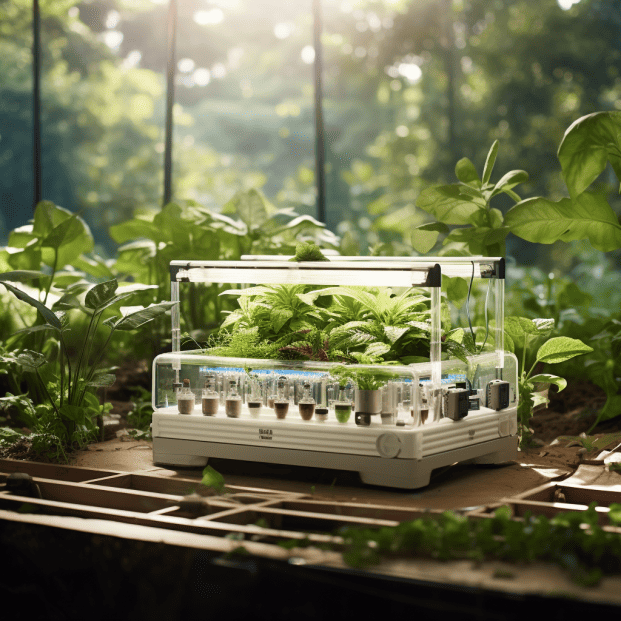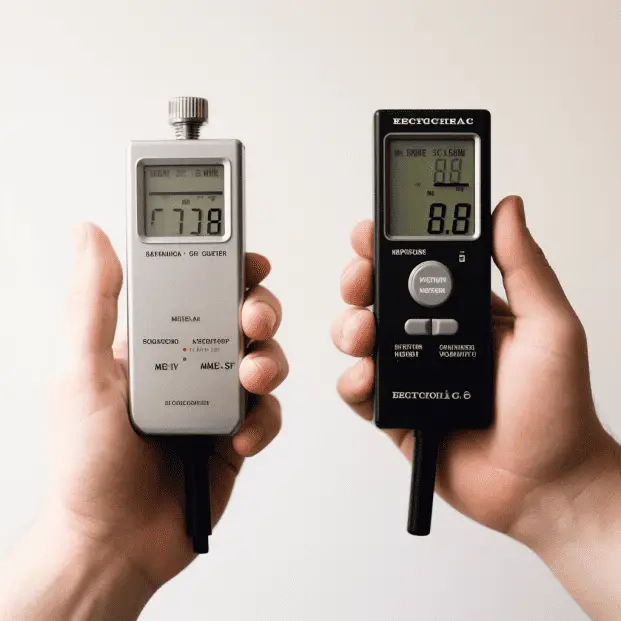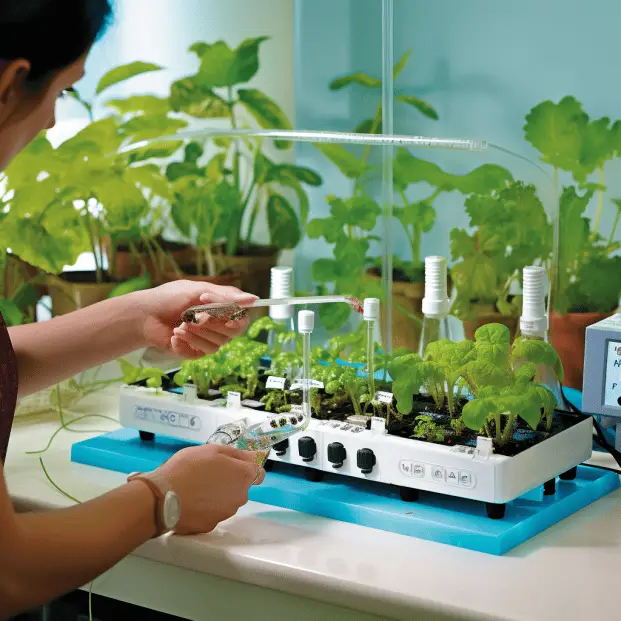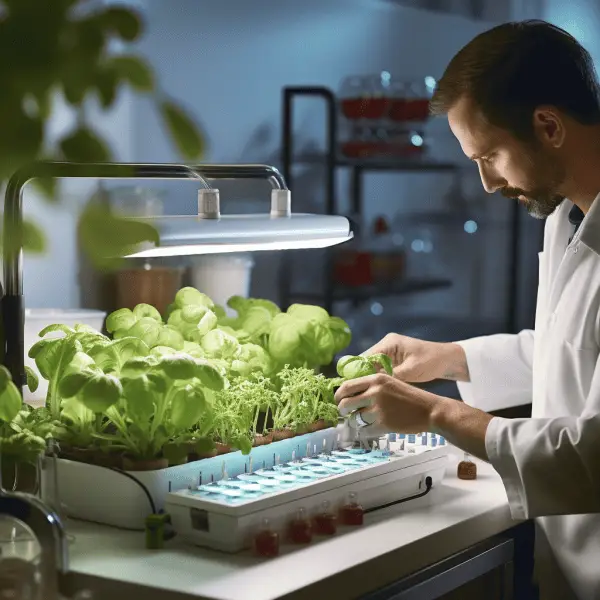Choosing an EC meter for hydroponics – sounds simple enough, right? Just grab any old conductivity gadget and stick it in your nutrient solution to measure stuff.
If only it were that easy!
I made that rookie mistake when I first started growing hydroponically.
Bought the cheapest EC meter I could find, tossed it in my reservoir and figured I was good to go.
Boy was I wrong! Turns out those inexpensive meters are wildly inaccurate.
I battled nutrient deficiencies for weeks before I realized my EC readings were totally off.
After that fiasco, I did my homework to find the best possible meter for my setup.
Along the way, I discovered some surprising truths about these devices.
Did you know some EC meters can’t actually measure nutrient solutions accurately? Or that cheap electrode probes degrade after a few months of use? I sure didn’t!
By the end, I became a bonafide EC meter expert.
After much trial and copious error, I finally found the perfect meter for my needs.
Today I’ll share everything I learned so you can avoid the headaches I faced.
Get ready for some EC meter truth bombs!
But first, a couple quick conductivity jokes to break the ice:
- What do you call an EC meter that’s full of itself? A con-CEIT-ed meter!
- Why was the EC meter sad? It had low con-DUCT-ivity!
Alright, science humor over.
Let’s dive into this miraculous world of hydroponic EC meters!
KEY TAKEAWAY
How am I choosing an EC meter for hydroponics?
Choosing an EC meter for hydroponics involves considering factors like accuracy, calibration options, and budget to ensure precise nutrient control and successful plant growth. (1)
It’s essential to research and compare different models to make an informed decision.
Why Use an EC Meter for Hydroponics?
An EC (electrical conductivity) meter is an essential tool for any hydroponic gardener.
EC measures the ability of a solution to conduct electricity, which corresponds directly to the total dissolved salts or nutrient concentration in the water.
Having an accurate reading of your hydroponic nutrient solution’s EC is important for several reasons:
Optimizing Plant Growth – Each plant variety requires nutrients within a specific EC range to thrive.
Too low, and plants become nutrient deficient.
Too high, and you risk nutrient toxicity and lockout.
An EC meter helps you prepare your hydroponic nutrients perfectly. (2)
Consistency – Maintaining a consistent EC throughout your grow cycle ensures your plants have a steady supply of nutrients.
Fluctuations in EC can stress plants and affect growth.
Troubleshooting – Sudden EC changes in your reservoir can indicate problems like equipment malfunctions, pH swings, or pathogens.
An EC meter helps you quickly identify issues.
Maximizing Inputs – By monitoring EC, you can maximize the use of your hydroponic nutrients and avoid waste.
Higher EC readings mean less nutrient concentrate needed to hit targets.
Having an EC meter on hand gives you the ability to precisely control nutrient levels and quickly correct any imbalances that may arise.
For hydroponic gardeners, it’s an indispensable tool.
Key Features to Look for in a Hydroponics EC Meter

When selecting a hydroponic item such as EC meter for your hydroponic system, there are a few key features to look for:
Accuracy – The ability to provide precise, reliable EC measurements is the most important consideration.
Look for accuracy within +/- 2%.
Resolution – Maximum resolution allows you to detect even subtle changes in your nutrient solution.
Aim for 0.01 EC resolution at a minimum.
Calibration – Meters must be calibrated periodically to maintain accuracy.
Models with auto calibration or calibration reminder alerts add convenience.
Temperature Compensation – Since temperature affects EC readings, meters should have automatic temperature compensation (ATC) to standardize results.
Durability – Meters for hydroponics should have waterproof, chemical resistant housing to withstand wet conditions and nutrient solutions.
Display – A clear, backlit display makes it easy to read your EC measurements in any lighting conditions.
Large digits are helpful.
Battery Life – Extended battery life reduces the frequency of battery replacements.
Auto-off helps conserve battery.
Warranty – A longer warranty provides more protection for your investment.
2+ years is preferable for EC meters.
When used properly, a high-quality EC meter designed for hydroponics will provide the accurate, consistent nutrient measurements you need to monitor and control your hydroponic systems.
Best EC Meters for Hydroponics

With all the EC meter options out there, it can be tricky choosing the right model for your hydroponic garden.
Based on critical features like accuracy, reliability, durability, and ease of use, here are some of the top-rated EC meters recommended for hydroponic applications:
Bluelab Pocket Pro – This compact, pocket-sized meter offers very high accuracy to +/- 1% with 0.01 EC resolution for precise measurements.
It’s fully waterproof with automatic temperature compensation.
Easy push-button calibration makes re-calibration a breeze.
Reliable name brand quality.
Hanna HI9813-6 – A versatile 2-in-1 meter that measures both EC and pH.
Waterproof housing and accuracy to +/- 2% meets the needs of most small hydroponic systems.
Large dual-line LCD easily shows separate EC and pH readings simultaneously.
Apera Instruments AI209 – Their premium PC60 model line provides laboratory grade accuracy to +/- 1% with a wide 0.01 mS/cm EC resolution.
It’s feature-packed with a replaceable EC probe module that extends meter longevity.
Helpful EC charts are also included.
Bluelab Combo Meter – The Bluelab Pro Combo Meter combines EC, pH and temperature measurement into one integrated, highly accurate unit.
It’s a popular choice among commercial growers for its durability and reliability.
Accuracy rated to +/- 1% EC.
HM Digital COM-100 – A great budget-friendly option, providing solid accuracy to +/- 2% EC with 0.01 resolution.
Very easy to use with one-touch automatic calibration.
Helpful for hydroponics hobbyists on a budget.
Sonkir MS02 – This 3-in-1 meter offers excellent value by combining EC, pH and moisture detection into one meter priced under $50.
Still provides lab-grade EC accuracy despite the low cost.
Wide 0.00-10.00 EC range.
No matter which model you choose from this list, prioritize quality, accuracy, durability, and ease of use.
Investing in a top-performing EC meter designed for hydroponics will give you the reliable readings and control you need for optimal plant growth.
Compare features carefully and look for strong user reviews.
With quality EC measurement, you can confidently fine-tune your nutrient solution for thriving plants.
How to Calibrate and Use an EC Meter for Hydroponics

Using and maintaining an EC meter properly is absolutely essential for getting accurate, consistent readings you can rely on.
Here are some key best practices:
Calibrate Frequently – Calibrating your EC meter before each use is highly recommended for maximum accuracy.
Use fresh calibration solution that matches the EC scale you plan to measure.
For example, use a 1.41 mS/cm solution for meters calibrated from 0 to 3999 μS/cm.
Follow the calibration steps in your user manual, allowing enough time for the probe to stabilize in the solution for a proper calibration.
Watch Temperature – Only measure EC when the temperature of your nutrient reservoir is steady.
Rapid temperature fluctuations can affect readings.
Let your reservoir reach room temperature before measuring.
Or use an EC meter with automatic temperature compensation (ATC) to standardize results.
Take Multiple Readings – Take readings in a few different spots throughout your reservoir or hydroponic flow channels to account for variability.
Stir or agitate nutrient solutions first to disperse any concentrated pockets.
Average multiple readings to determine overall EC.
Rinse Probes – Be sure to rinse the EC probe with distilled or deionized water before and after taking measurements.
This prevents cross-contamination between different nutrient solutions or reservoirs.
Extended soaking in calibration solution can also foul probes.
Clean Probes – Over time, mineral nutrient salts, algae and other debris can buildup on EC probe surfaces affecting their conductivity.
Gently clean probes as needed with a soft brush and mild soap like liquid dish detergent.
Avoid abrasive cleaning.
Replace Probes – If readings seem inconsistent or drift over time after cleaning, EC probe replacement may be necessary.
Check your meter’s manual for any recalibration procedures or steps needed when replacing probes.
Check Batteries – Low batteries in your meter can affect performance and accuracy.
Replace batteries promptly when a low battery warning is indicated.
Some models allow battery replacement without losing calibration.
Store Properly – Keep your EC meter clean by rinsing probes after use.
Store the meter safely with the probe immersed in tap water or electrolyte storage solution – never allow probes to dry out.
Closely following the manufacturer’s instructions for calibration frequency, probe cleaning, battery replacement and overall meter maintenance will help keep your EC meter functioning at peak accuracy.
Precise readings lead to optimal nutrient levels.
Interpreting EC Measurements in Hydroponic Systems

Understanding what your EC meter readings mean is critical for dialing in the optimal nutrient levels:
- Higher EC levels indicate more dissolved salts/nutrients in the water
- Target EC ranges vary widely between plant species. Leafy greens prefer lower EC while tomatoes need higher levels.
- Seedlings and young plants need lower EC in the 400-800 μS/cm range. Mature plants thrive up to 1400+ μS/cm for some crops.
- Indoor systems need higher EC to make up for lack of natural fertility. Outdoor systems use lower EC closer to soil levels.
- Watch for EC changes between reservoir and drainage. Differences greater than +/- 0.4 EC could indicate a problem.
- Compare EC readings to your visual plant observations. Increase/decrease nutrients according to plant response.
- Keep daily notes on EC along with pH to track changes and tune your system.
While general EC guidelines are available, monitoring your specific system and plants will determine the optimal target ranges for growth. Take notes and adjust to find the right balance.
EC Level Troubleshooting for Hydroponic Nutrient Solutions
Fluctuating or unstable EC levels in your hydroponic reservoir can cause multiple issues.
Here are some potential problems and solutions:
Rising EC – This indicates too many nutrients are accumulating. Perform a reservoir change to reset EC to target levels. Increase water change frequency.
Falling EC – Usually caused by nutrient depletion from plant uptake. Replenish nutrients to reach your desired EC target levels.
Erratic Swings – Could signify pH instability, temperature fluctuations or equipment malfunctions. Check your pH and equipment first before adjusting nutrients.
Different Between Reservoir and Drainage – More than 0.4 EC difference can indicate a buildup or depletion within your system. Flush entire system and monitor.
EC Higher than Target – Reduce nutrient concentration if EC is too high. For most systems, the ideal range is 1.0 – 2.2 EC. Excess salts can cause toxicity.
EC Lower than Target – Mix nutrients more concentrated if EC is too low. Deficiency symptoms like yellowing often appear when EC falls below 1.0.
Regularly monitoring and troubleshooting EC levels can help you avoid issues with root stress, nutrient lockout, algae growth and more. Keep an eye on those EC readings!
Affordable EC Meter Options for Hydroponic Growers
Investing in a quality EC meter is essential for hydroponic gardeners, but cost can be a concern, especially for home growers and small systems.
Thankfully, there are many accurate and reliable EC meter options available for under $50 to fit any budget:
- HM Digital COM-100 – This simple, precise handheld model provides consistent EC measurements with push-button calibration and automatic temperature compensation for accuracy. The large LCD screen clearly displays readings.
- Apera Instruments AI311 – Part of Apera’s premium series line, this model offers impressive lab-grade accuracy. The replaceable probe design extends the lifespan of this quality EC meter. Helpful measurement charts are also included.
- Bluelab Pocket Pro – A compact and water resistant meter from a top hydroponic brand. The auto shut-off feature helps preserve battery level. Easy push-button calibration enables accurate readings.
- Sonkir MS02 – A versatile 3-in-1 meter that adds pH and moisture detection along with EC. The 0.00-10.00 EC range provides high resolution measurements. Great value.
- Dr.meter EC613 – The palm-sized design is great for small hydroponic systems. It delivers highly accurate EC readings on its large backlit LCD display for easy viewing.
- Gain Express GE171 – A durable and fully waterproof model capable of precise 0.01 EC resolution. The meter is designed for long life in wet conditions.
- Horiba LAQUA Twin B-771 – An option from a trusted scientific equipment company. Automatic temperature compensation allows accurate EC measurements.
- HONEForest Conductivity Tester – The convenient floating orb design makes testing ponds and reservoirs easy. Low battery indicator alerts users to replace AAA batteries.
While generic EC pens can develop accuracy issues over time, investing a little more upfront in a proven budget meter for hydroponics like the Bluelab Guardian Monitor will provide better reliability and performance long-term.
Maintaining and Caring for Your Hydroponics EC Meter
To keep your EC meter functioning properly for accurate readings:
- Calibrate before each use according to the user manual. This is essential for consistency.
- Store the meter with the probe immersed in tap water or storage solution. Never allow the probe to dry out.
- Rinse the probe with distilled water before and after taking readings to prevent cross-contamination.
- Inspect probes regularly for debris, salt buildup or damage. Gently clean with a soft brush and mild detergent.
- Replace probes once they become worn or readings are inconsistent. Many meters allow you to easily swap probes.
- Check connectors to ensure cables are fully seated for proper contact.
- Watch for error messages indicating issues like low battery or calibration needed.
- Keep spare batteries on hand so you can replace them before they run out.
- Follow all guidelines in the user manual for meter care, maintenance and storage.
With proper use and care, a quality EC meter should deliver consistent, accurate results for many grow seasons before probe replacement is needed.
Calibrate it, clean it and don’t let it dry out!
Frequently Asked Questions
How often should I be taking EC readings with my hydroponic EC meter?
For optimal plant growth in your hydroponic garden, it’s recommended to check and record the EC at least once daily with a quality hydroponic EC meter designed specifically for measuring nutrient solutions.
Closely monitoring your hydroponic nutrient solution EC on a daily basis allows you to review trends over the past week and make any adjustments needed to maintain your target EC levels that are ideal for your specific crops.
Investing in an accurate and reliable digital EC meter for hydroponics like the best EC meters for hydroponics.
Using a quality conductivity meter designed for hydroponics with automatic temperature compensation helps provide accurate EC readings of your hydroponic nutrient solutions.
Carefully tracking the EC levels in your hydroponic system ensures your plants get the proper nutrient balance for optimal growth.
What EC level is best for my hydroponic system?
Ideal EC ranges will vary depending on the specific plant varieties, growth stages, and your individual hydroponic gardening environment.
Most plants thrive at EC levels from 1.0-2.2 mS/cm in hydroponic systems, but your targets need to be fine-tuned and adjusted based on careful observation of your plants’ specific response to the nutrient solutions.
Quality EC meters for hydroponics like the best EC meters for hydroponics from Apera Instruments or Bluelab with high accuracy and automatic temperature compensation provide the precise EC measurement needed to optimize your hydroponic nutrients.
Using a digital pH meter for hydroponics along with a quality EC meter enables accurate readings of both key factors in your hydroponic nutrient solutions.
Careful calibration and maintenance of your hydroponic meters for electrical conductivity and pH ensures the accuracy needed to dial in optimal nutrient levels for your crops.
Do I need to calibrate my hydroponics EC meter? How often?
Yes, calibrating your digital EC meter for hydroponics before each use is highly recommended for maximum accuracy and stable readings of your hydroponic nutrient solutions.
Be sure to use fresh calibration solutions that match the EC scale of your particular hydroponic meter.
Calibrate at a minimum of once weekly, but the most dedicated hydroponic gardeners calibrate daily for consistent EC readings that accurately reflect the nutrient content and concentration.
Investing in an easy to calibrate lightweight handheld digital meter for hydroponics like the HM Digital COM-100 with one-touch calibration and battery level indicator can make this essential task quick and hassle-free.
Follow the calibration instructions in your meter’s manual to adjust the electric current response and ensure accurate measurements of the individual nutrient components and overall level of nutrients.
Proper calibration is essential for monitoring the nutrient uptake by your plants and maintaining optimal nutrient balance for healthy hydroponic plants.
Why do my hydroponic EC readings fluctuate so much between tests?
Temperature changes and meter calibration status are the most common reasons for EC measurement fluctuations.
Using a quality EC meter designed specifically for hydroponics with automatic temperature compensation (ATC), like the Bluelab Combo Meter, helps standardize results across water temperatures.
Regular calibration is also crucial for stability in hydroponic nutrient EC readings.
Top brands like Hanna Instruments or Bluelab have models with reminders to calibrate.
How can I lower high EC levels in my hydroponic reservoir?
If your hydroponic nutrient solution EC creeps too high for your crop’s requirements, try doing a complete reservoir change with fresh water to dilute concentrations.
You can also increase the frequency of your reservoir water changes to prevent nutrient buildup.
Or simply reduce the dosing of your hydroponic nutrient concentrates at the next reservoir refill to bring levels down.
Quality EC meters for hydroponics allow close monitoring to catch rising EC.
What causes rising EC levels in my hydroponic system over time?
As your plants uptake water during growth, the hydroponic nutrients and dissolved salts become more concentrated and EC levels slowly rise.
You can counteract this natural increase by topping off your reservoir periodically with plain pH-adjusted water.
Combination EC and pH meters for hydroponics like the Sonkir MS02 make it easy to monitor both key factors.
How should I clean mineral buildup off my hydroponic EC probe?
Gently remove any stubborn mineral or hydroponic nutrient salt buildup from EC probe surface by cleaning with a very soft brush and mild detergent – avoid abrasive scrubbing.
Rinsing probes in distilled or deionized water after each use can help minimize deposits.
Take care of your probes and your EC meter will give you accurate hydroponic readings for years.
Should I buy a combo EC-pH meter or separate EC and pH meters for my hydroponics system?
Combo EC and pH meters designed for hydroponics provide added convenience by combining both critical measurements into one tool, but require you to replace the entire unit if either the EC or pH probe fails.
Separate EC and pH meters for hydroponics allow you to replace only the faulty probe as needed.
Both options from quality brands like Hanna Instruments or Apera can serve a hydroponic garden well with proper use and maintenance.
Conclusion
Whew, we covered a ton of ground on picking the ideal EC meter for your hydroponic system! From electrode types to display features, it’s certainly more complex than grabbing any old meter.
But now you’re armed with insider knowledge on identifying quality meters that provide accurate, consistent readings.
No more tearing your hair out over erroneous EC numbers or replacing faulty probes every few months!
You may be tempted to cheap out on an EC meter, but don’t do it! Spending a bit more upfront for a top-tier brand with replaceable probes will save you endless headaches down the road.
Before you pull the trigger, be sure to double check that the meter meets your grow setup’s specific needs.
With the right device in hand, you can precisely monitor and adjust your nutrient solutions for maximum plant health and yield.
No more nutrient deficiencies!
Hungry for more hydroponic growing tips? Stay tuned for my next guide on choosing the perfect water pumps for an efficient, high-performing system
Selecting a Hydroponic Water Pump: A Comprehensive Guide
References
- https://www.producegrower.com/article/equipment-choosing-the-right-phec-meter/
- https://extension.okstate.edu/fact-sheets/electrical-conductivity-and-ph-guide-for-hydroponics.html
Related Articles
- https://tophydroponicgarden.com/understanding-ec-in-hydroponics/
- https://tophydroponicgarden.com/ec-meter/
- https://tophydroponicgarden.com/items-needed-for-hydroponic-system/
You May Like These…
Streamlining Hydroponic Monitoring: The Latest Automation Tools – Discover automation solutions for effortless hydroponic management.
Mastering Nutrient Control: Advanced Tips for Hydroponic Success – Unlock the secrets to achieving superior plant growth in hydroponics.
Efficiency Hacks: Time-Saving Tips for Hydroponic Enthusiasts – Discover time-saving tricks to boost your hydroponic productivity.
Was this helpful?

Crystal Erickson is an agriculture enthusiast and writer with a passion for sustainable farming practices and community development. Growing up on a family farm in rural Iowa, Crystal developed a love for the land and a deep appreciation for the hard work and dedication required to make a farm successful.
After completing a degree in Agriculture and Environmental Science from Iowa State University, Crystal began her career as an agricultural journalist, covering stories and issues related to modern farming practices, crop management, and livestock production. She quickly established herself as a respected voice in the industry, known for her insightful reporting and thoughtful analysis.
Over the years, Crystal has written for a variety of publications, including Farm Journal, Successful Farming, and Modern Farmer, as well as contributing to several academic journals focused on sustainable agriculture and community development. Her work has been recognized with numerous awards, including the Iowa Farm Bureau’s Young Farmer Achievement Award and the National Association of Farm Broadcasting’s Farm Broadcaster of the Year.


